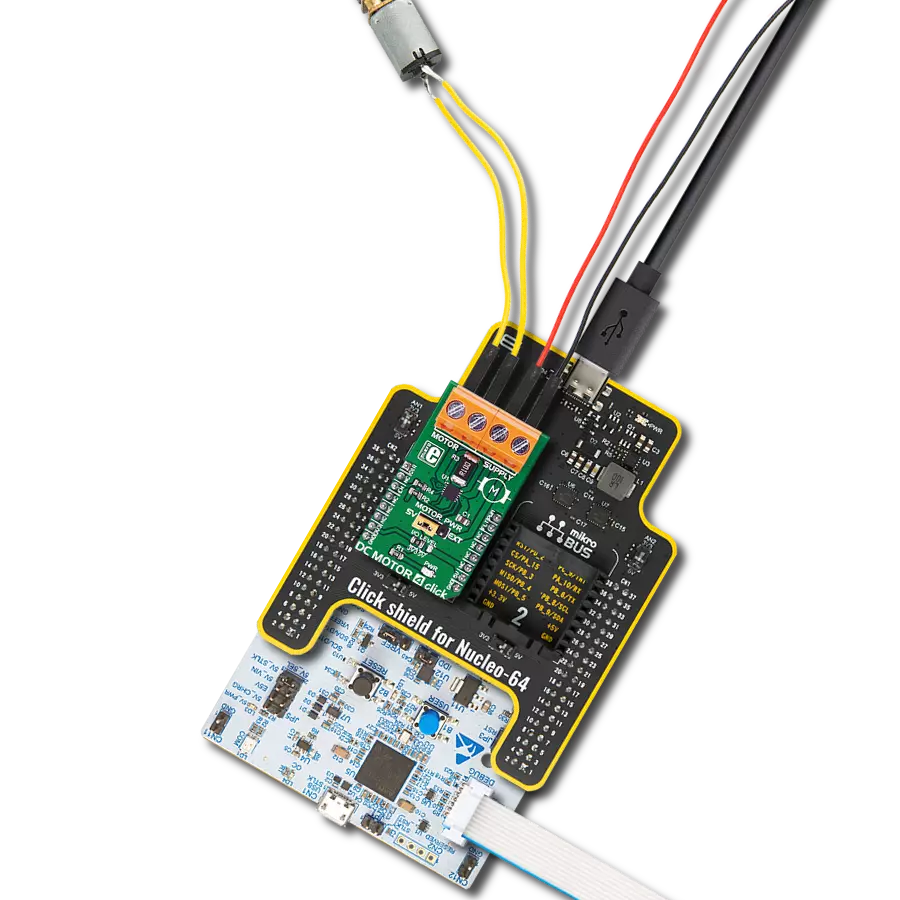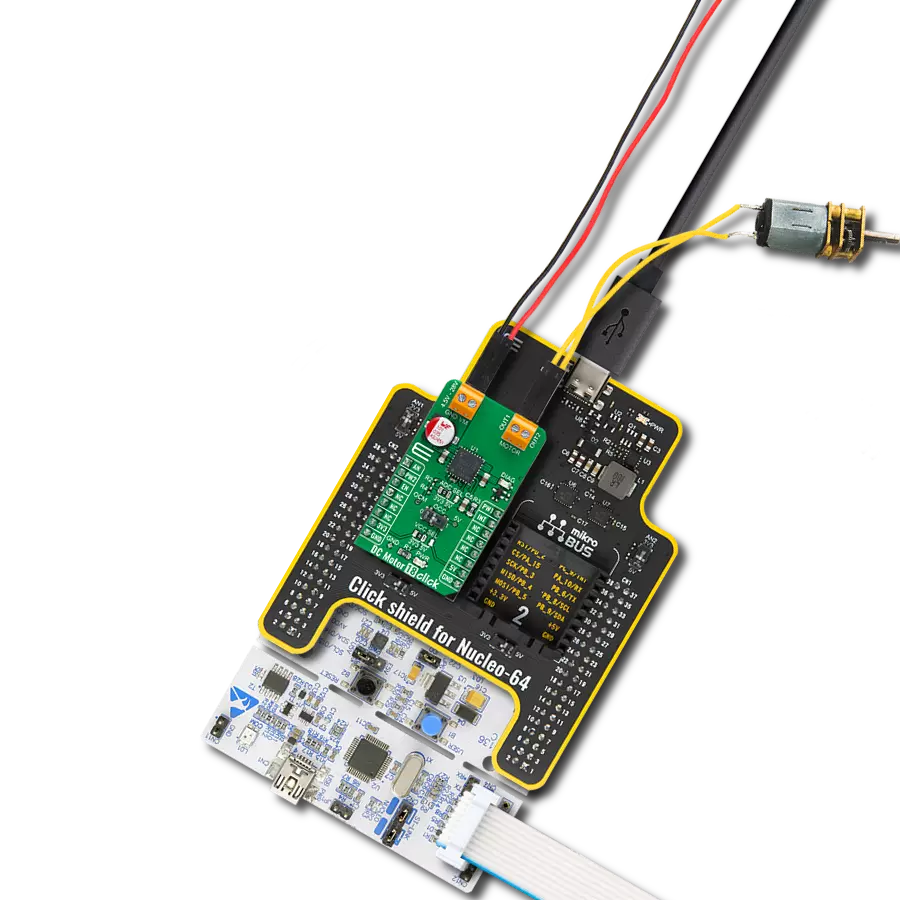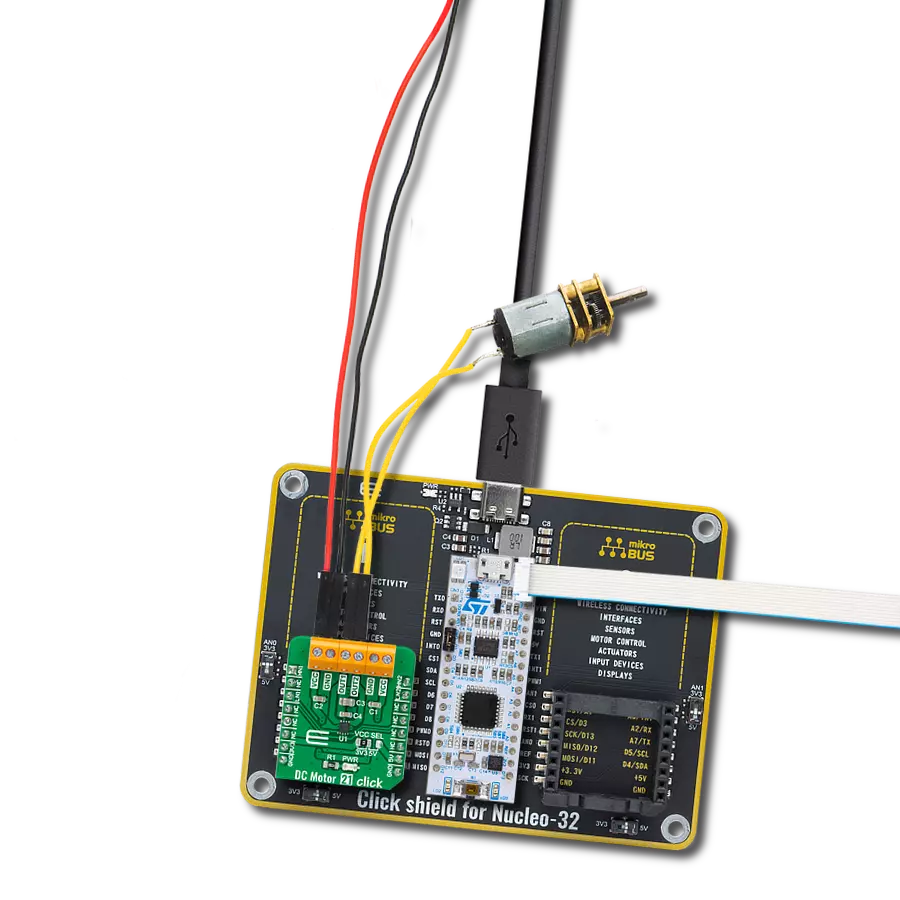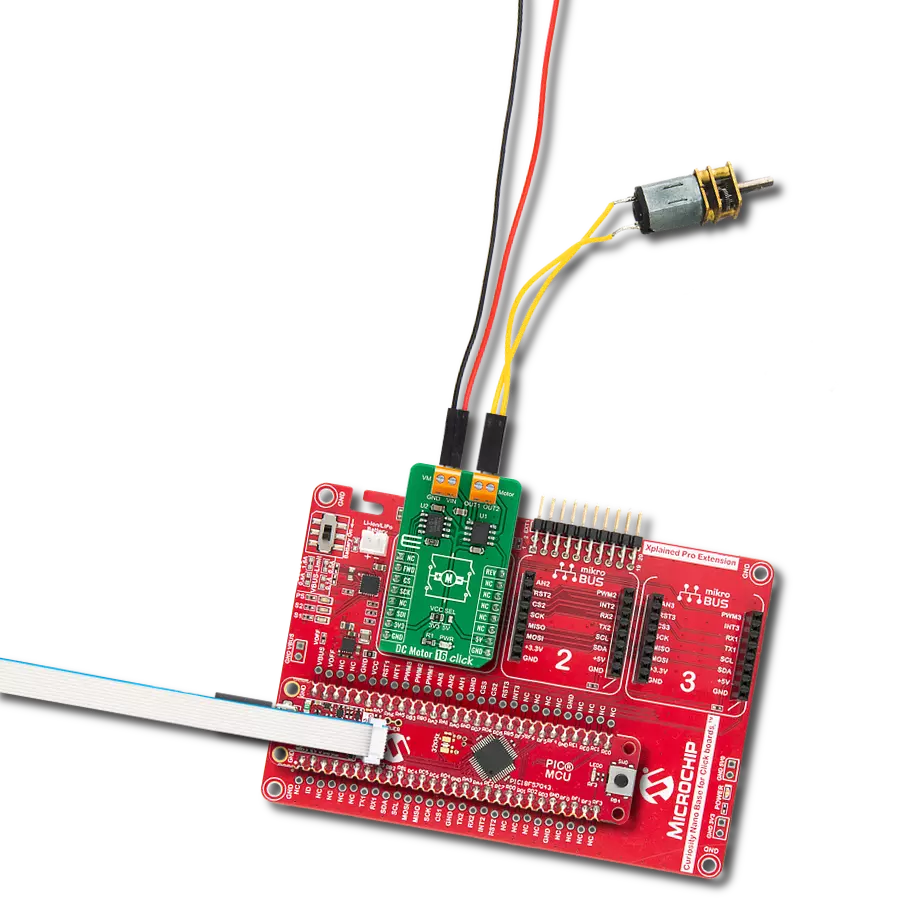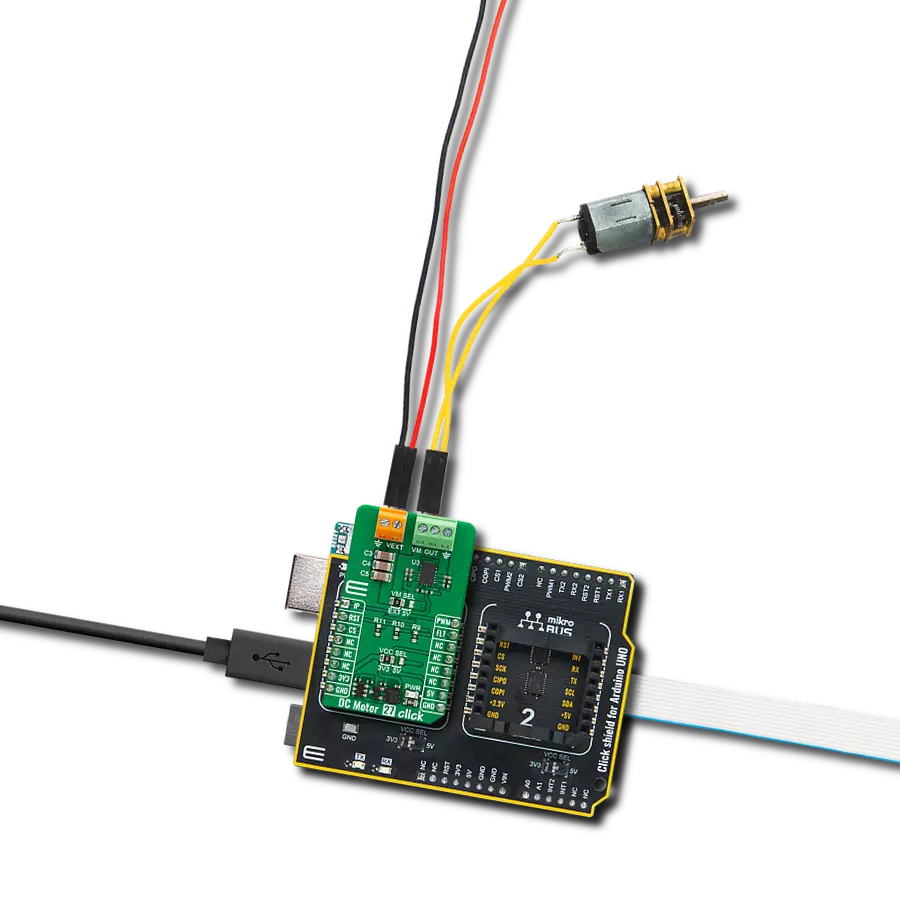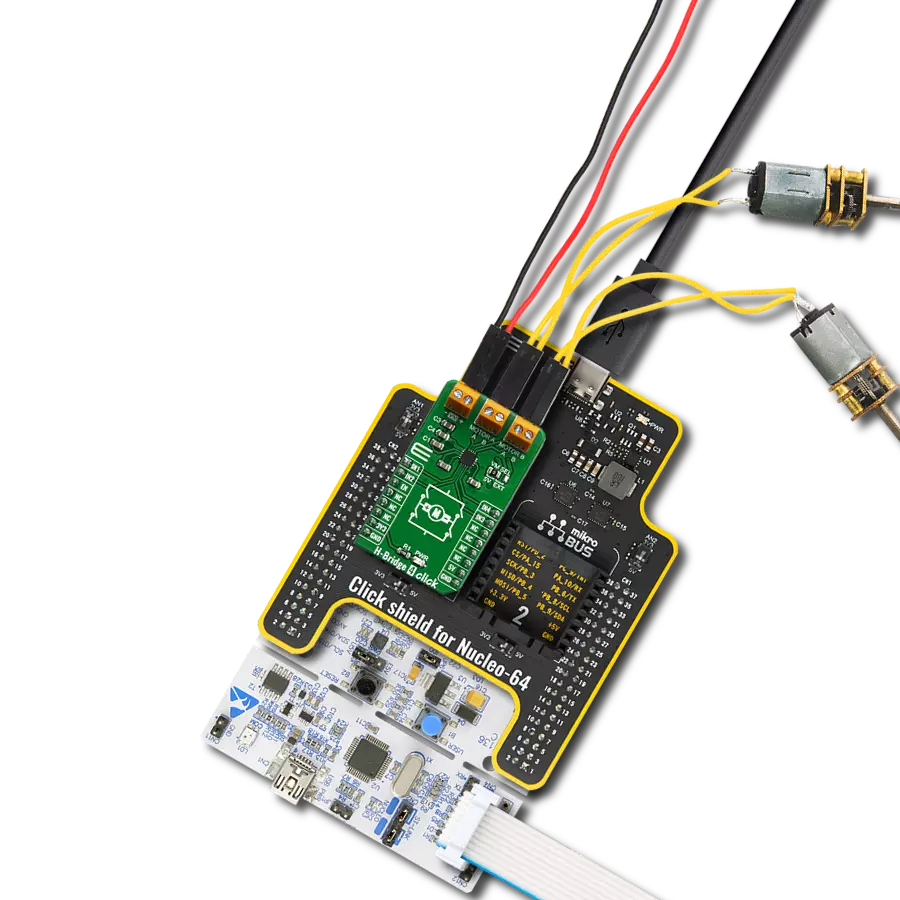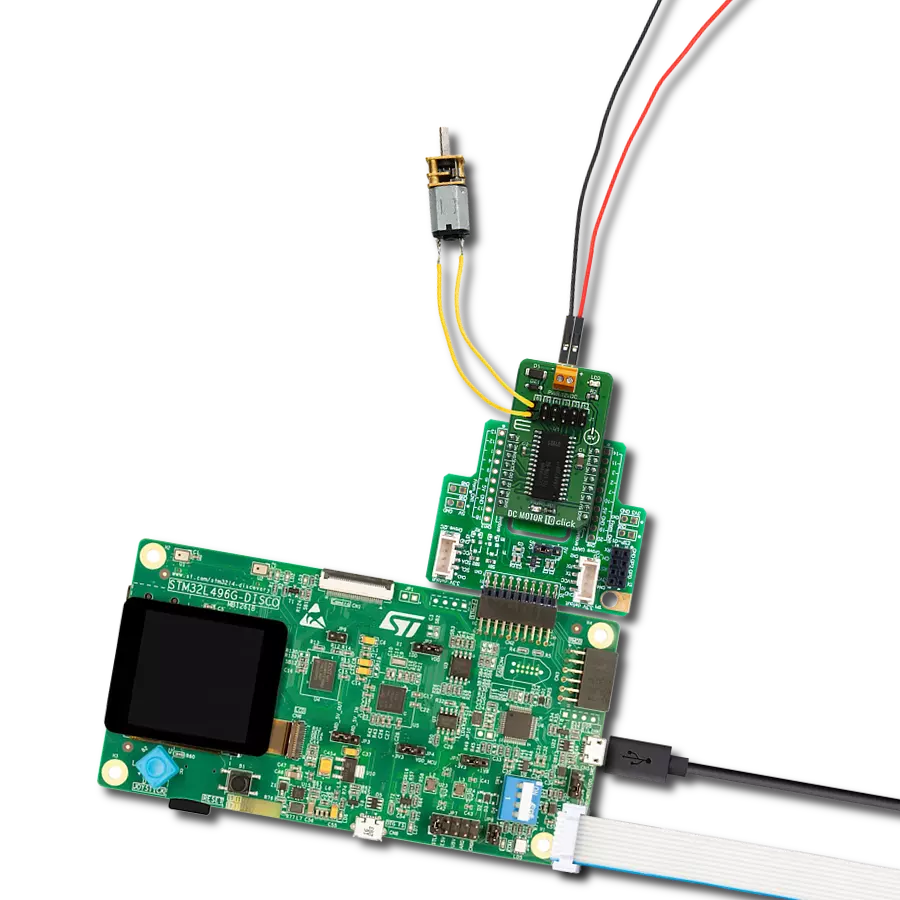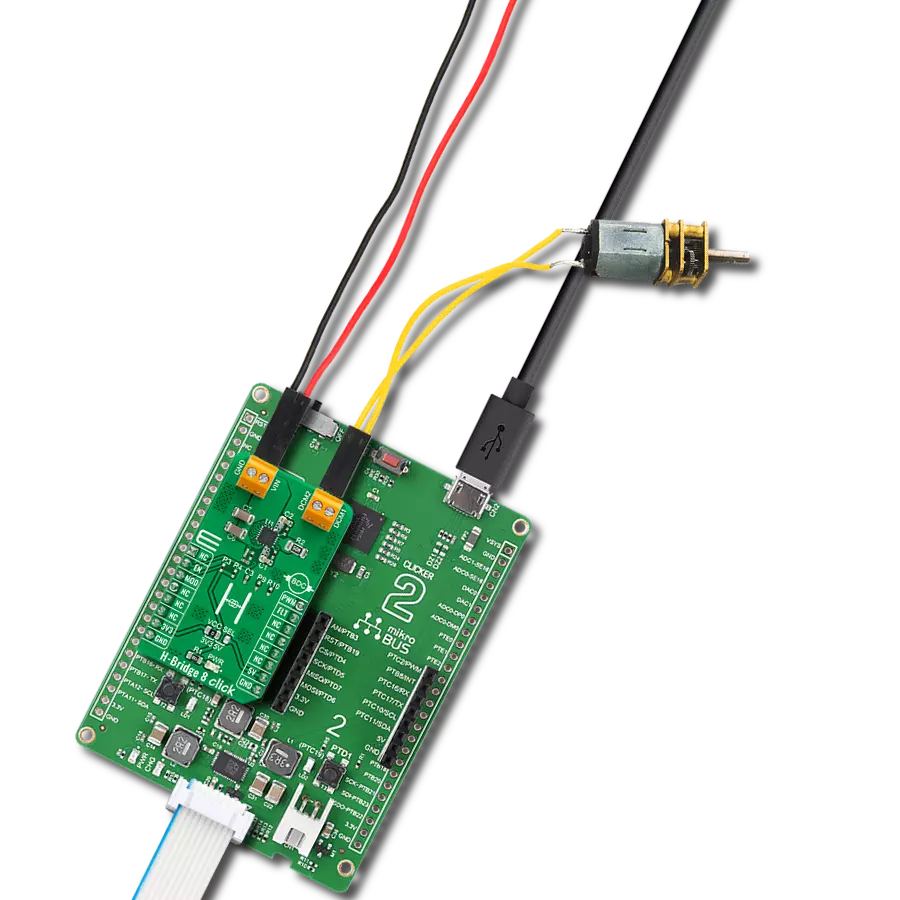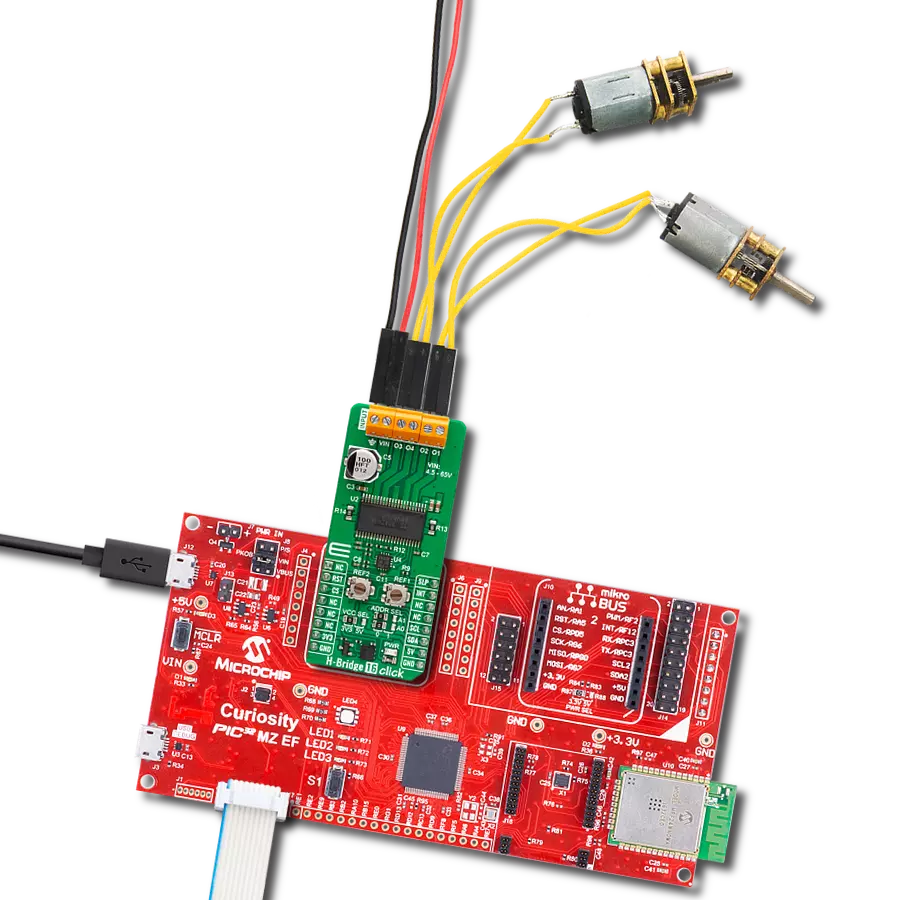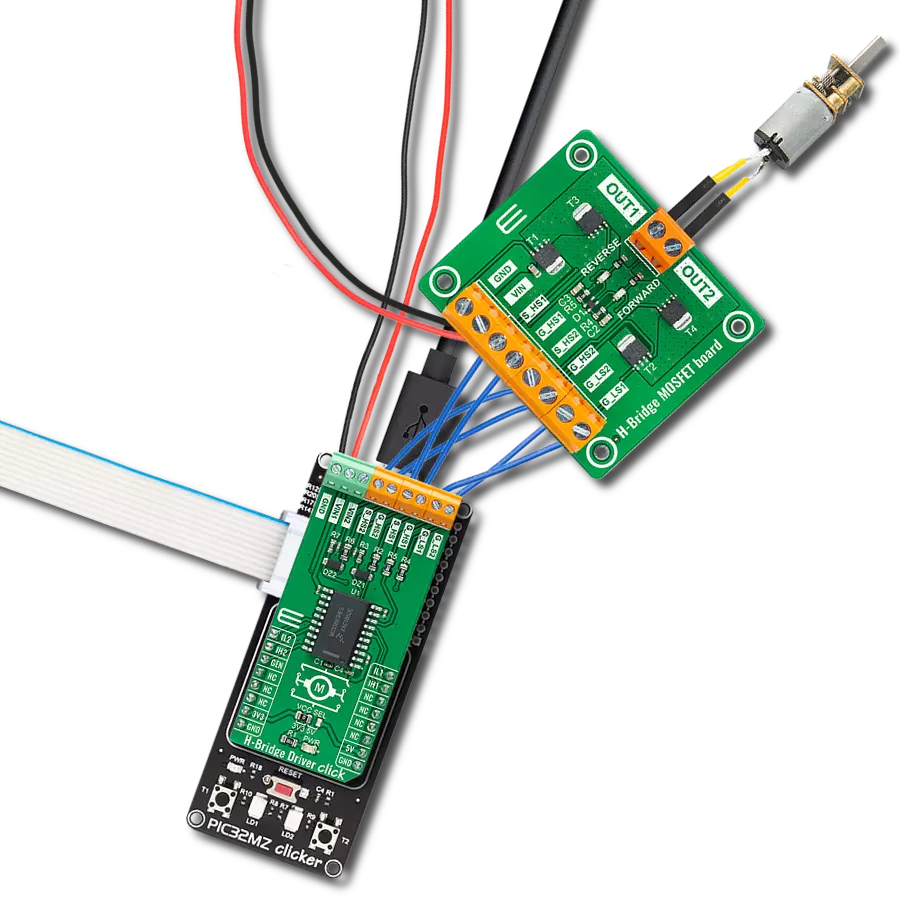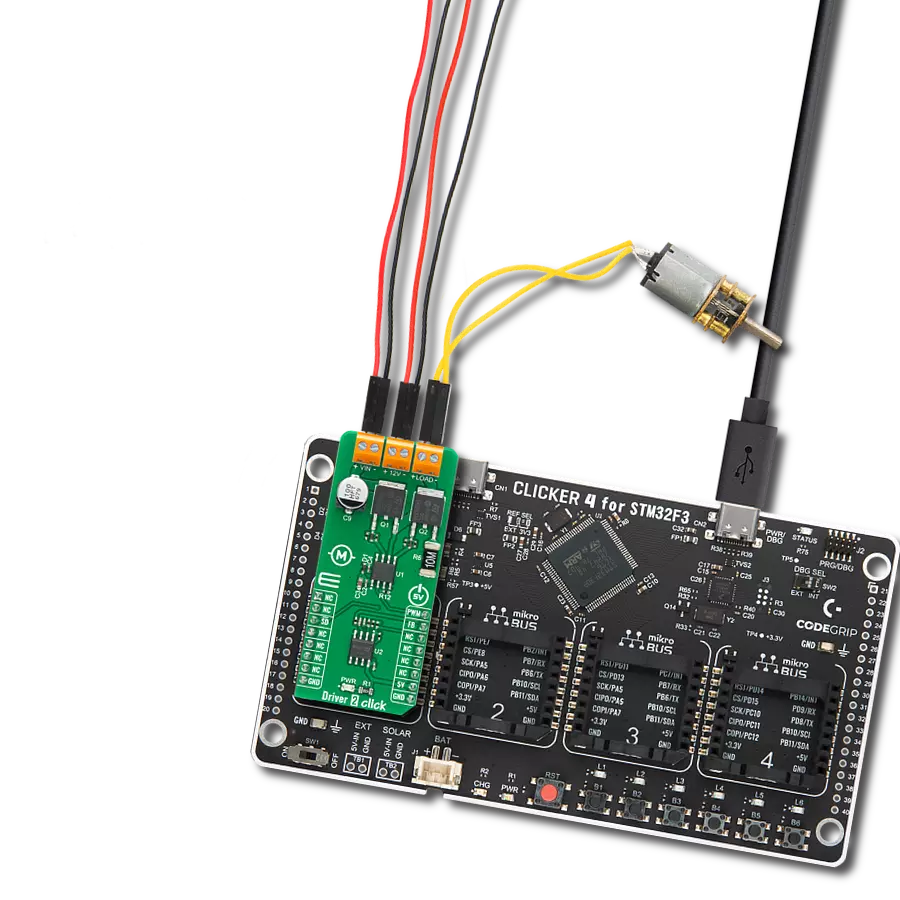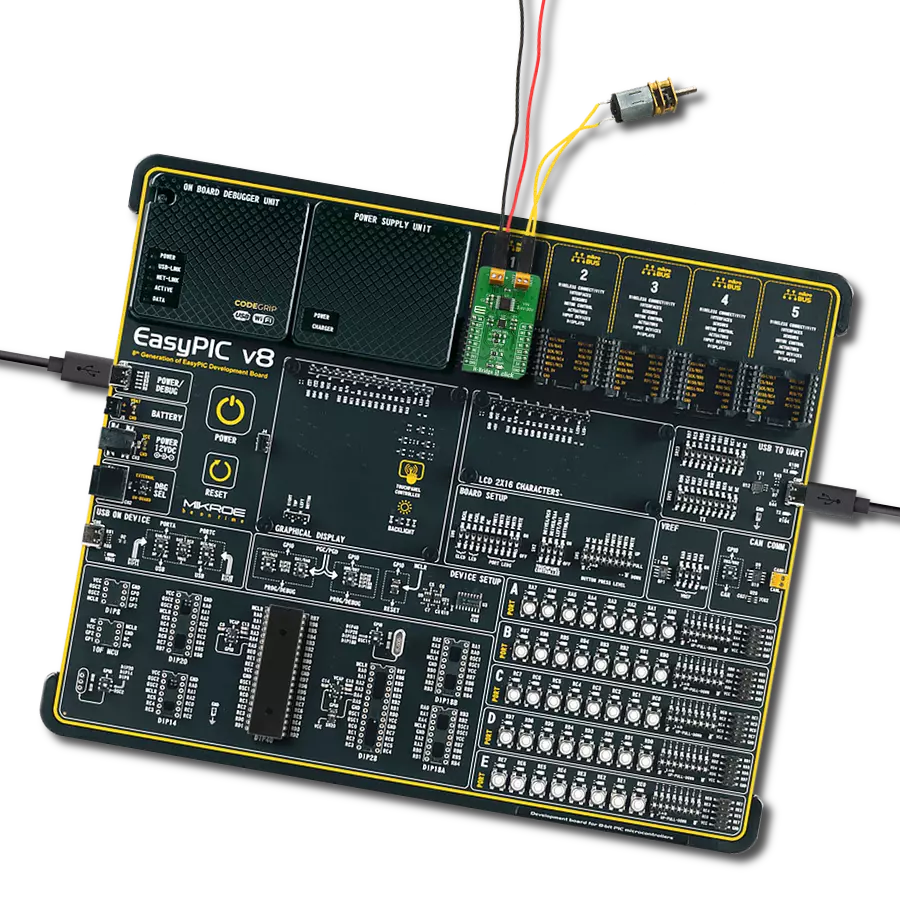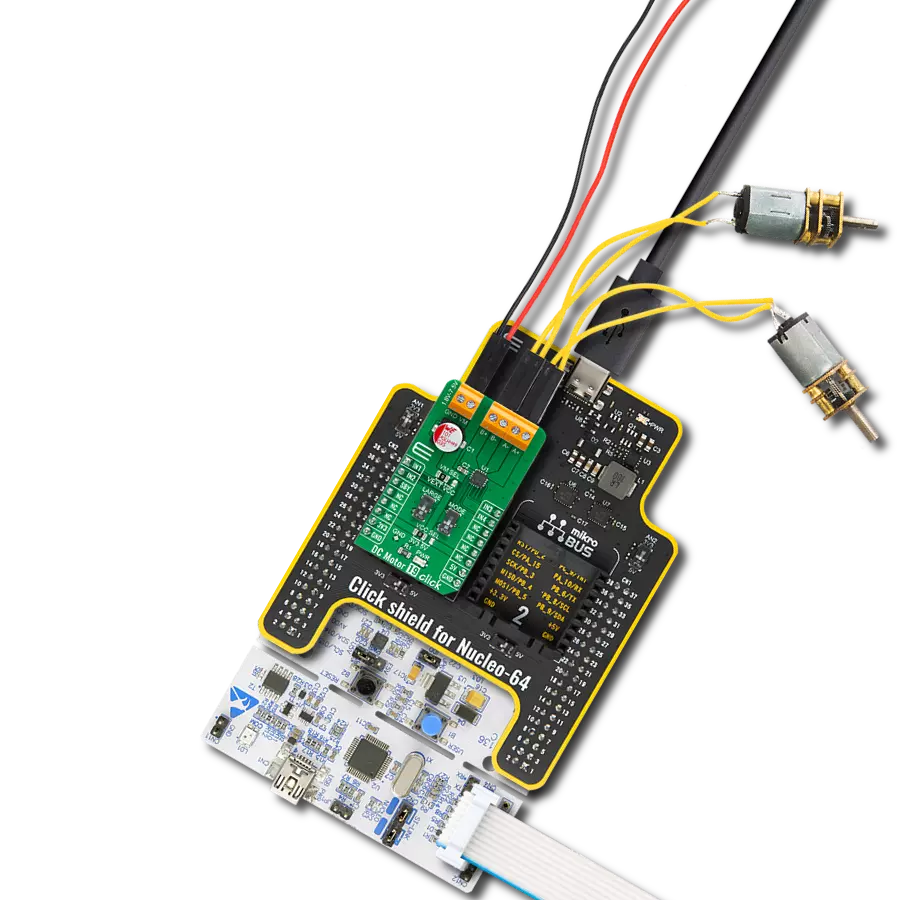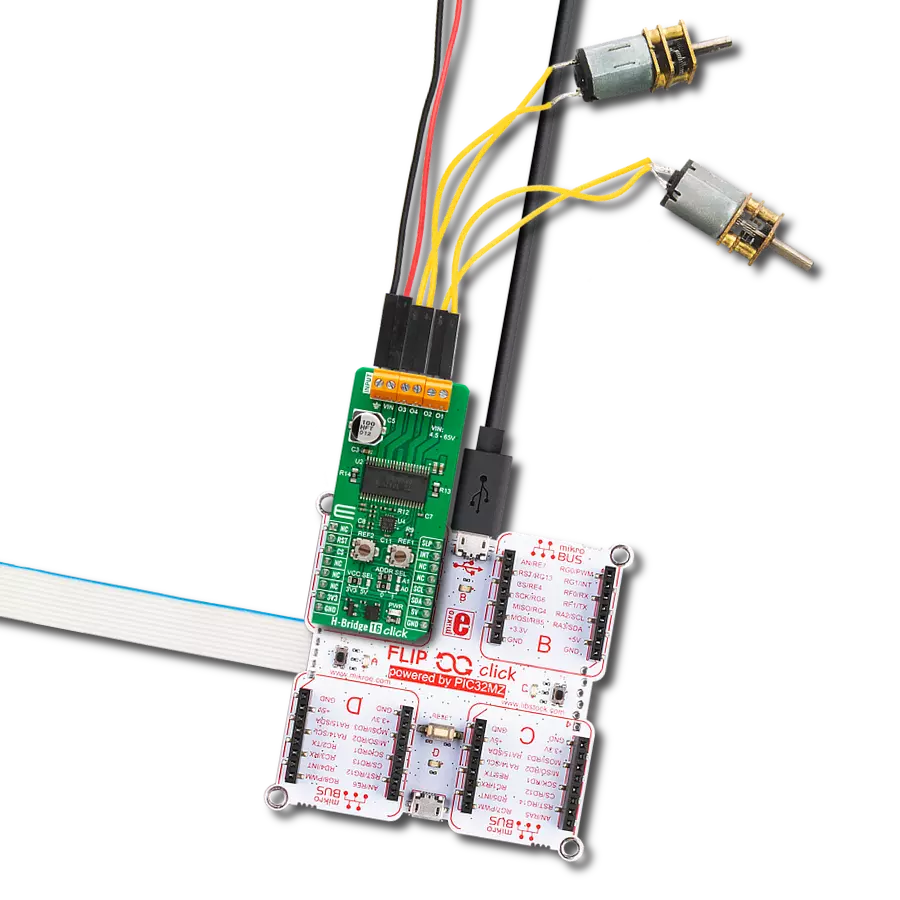Simplify your motion control challenges and amplify performance across industries with our reliable and adaptable DC motor driver solution.
A
A
Hardware Overview
How does it work?
DC Motor 23 Click is based on the TB67H480FNG, a dual-channel, H-bridge, brushed DC motor driver from Toshiba Semiconductor. The TB67H480FNG has a current limit function that monitors the current flowing in the motor. When the motor current reaches the set current value, determined using onboard VREF trimmers (VREFA and VREFB), it shifts to Decay mode, selectable by positioning the SMD jumper labeled as DECAY to an appropriate position marked as 0 and 1, for a fixed OFF time and attenuates the current. The TB67H480FNG has a built-in regulator that allows the motor to be driven by a single power supply, provides a motor output voltage rating of around 40V, and has integrated protection mechanisms such as over-current, over-temperature, and under-voltage lockout for error detection. The setting current value can be adjusted with the torque function (100%, 71%, 38%,
or 0%), controlled through the PCA9538A port expander, which establishes communication with the MCU via the I2C serial interface. Lowering the torque setting can suppress the motor current when high torque is unnecessary. In addition to these torque setting pins, with the help of the expander, it is also possible to control some other signals, such as the control signals for selecting the operating mode of the motor driver. These pins, in combination with ENA and ENB pins, routed to default positions of CS and PWM pins of the mikroBUS™ socket, enable operational modes like CW, CCW, or short-brake. The PCA9538A also allows choosing the least significant bit (LSB) of its I2C slave address by positioning SMD jumpers labeled as ADDR SEL to an appropriate position marked as 0 and 1, alongside its interrupt feature routed to the INT pin of the mikroBUS™ socket. Besides, all circuits can be stopped using the
Sleep function, routed to default positions of the AN pin of the mikroBUS™ socket, and thus enable power saving mode, while the RST pin provides a general-purpose reset function. The DC Motor 23 Click supports an external power supply for the TB67H480FNG, which can be connected to the input terminal labeled as VM and should be within the range of 8.2V to 44V, while the two brushed or one stepping motor coils can be connected to the terminals labeled as B+, B-, A-, and A+. This Click board™ can operate with either 3.3V or 5V logic voltage levels selected via the VCC SEL jumper. This way, both 3.3V and 5V capable MCUs can use the communication lines properly. Also, this Click board™ comes equipped with a library containing easy-to-use functions and an example code that can be used as a reference for further development.
Features overview
Development board
Arduino Mega 2560 is a robust microcontroller platform built around the ATmega 2560 chip. It has extensive capabilities and boasts 54 digital input/output pins, including 15 PWM outputs, 16 analog inputs, and 4 UARTs. With a 16MHz crystal
oscillator ensuring precise timing, it offers seamless connectivity via USB, a convenient power jack, an ICSP header, and a reset button. This all-inclusive board simplifies microcontroller projects; connect it to your computer via USB or power it up
using an AC-to-DC adapter or battery. Notably, the Mega 2560 maintains compatibility with a wide range of shields crafted for the Uno, Duemilanove, or Diecimila boards, ensuring versatility and ease of integration.
Microcontroller Overview
MCU Card / MCU
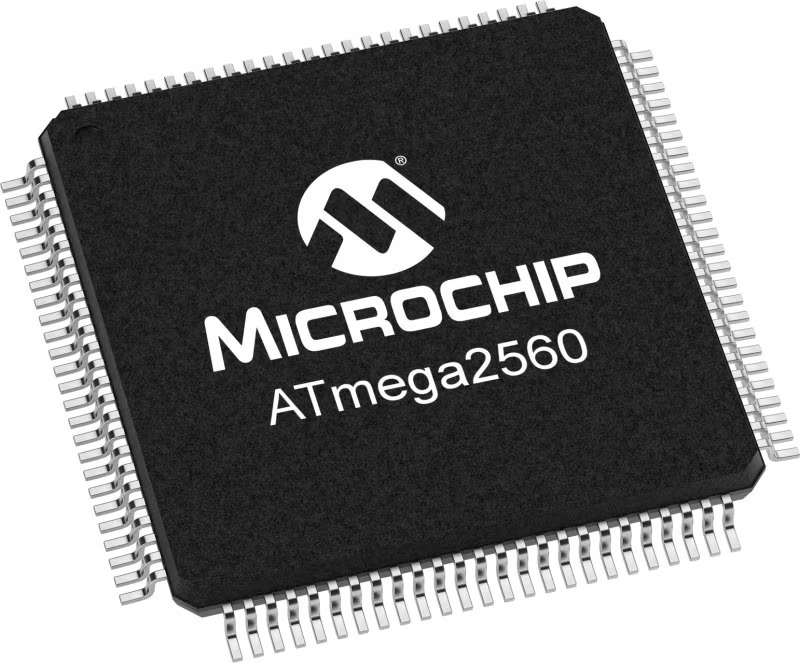
Architecture
AVR
MCU Memory (KB)
256
Silicon Vendor
Microchip
Pin count
100
RAM (Bytes)
8192
You complete me!
Accessories
Click Shield for Arduino Mega comes equipped with four mikroBUS™ sockets, with two in the form of a Shuttle connector, allowing all the Click board™ devices to be interfaced with the Arduino Mega board with no effort. Featuring an AVR 8-bit microcontroller with advanced RISC architecture, 54 digital I/O pins, and Arduino™ compatibility, the Arduino Mega board offers limitless possibilities for prototyping and creating diverse applications. This board is controlled and powered conveniently through a USB connection to program and debug the Arduino Mega board efficiently out of the box, with an additional USB cable connected to the USB B port on the board. Simplify your project development with the integrated ATmega16U2 programmer and unleash creativity using the extensive I/O options and expansion capabilities. There are eight switches, which you can use as inputs, and eight LEDs, which can be used as outputs of the MEGA2560. In addition, the shield features the MCP1501, a high-precision buffered voltage reference from Microchip. This reference is selected by default over the EXT REF jumper at the bottom of the board. You can choose an external one, as you would usually do with an Arduino Mega board. There is also a GND hook for testing purposes. Four additional LEDs are PWR, LED (standard pin D13), RX, and TX LEDs connected to UART1 (mikroBUS™ 1 socket). This Click Shield also has several switches that perform functions such as selecting the logic levels of analog signals on mikroBUS™ sockets and selecting logic voltage levels of the mikroBUS™ sockets themselves. Besides, the user is offered the possibility of using any Click board™ with the help of existing bidirectional level-shifting voltage translators, regardless of whether the Click board™ operates at a 3.3V or 5V logic voltage level. Once you connect the Arduino Mega board with Click Shield for Arduino Mega, you can access hundreds of Click boards™, working with 3.3V or 5V logic voltage levels.
DC Gear Motor - 430RPM (3-6V) represents an all-in-one combination of a motor and gearbox, where the addition of gear leads to a reduction of motor speed while increasing the torque output. This gear motor has a spur gearbox, making it a highly reliable solution for applications with lower torque and speed requirements. The most critical parameters for gear motors are speed, torque, and efficiency, which are, in this case, 520RPM with no load and 430RPM at maximum efficiency, alongside a current of 60mA and a torque of 50g.cm. Rated for a 3-6V operational voltage range and clockwise/counterclockwise rotation direction, this motor represents an excellent solution for many functions initially performed by brushed DC motors in robotics, medical equipment, electric door locks, and much more.
Used MCU Pins
mikroBUS™ mapper
Take a closer look
Click board™ Schematic

Step by step
Project assembly
Software Support
Library Description
This library contains API for DC Motor 23 Click driver.
Key functions:
dcmotor23_set_clockwise- DC Motor 23 set clockwise function.dcmotor23_set_counter_clockwise- DC Motor 23 set counter clockwise function.dcmotor23_set_decay- DC Motor 23 set decay function.
Open Source
Code example
The complete application code and a ready-to-use project are available through the NECTO Studio Package Manager for direct installation in the NECTO Studio. The application code can also be found on the MIKROE GitHub account.
/*!
* @file main.c
* @brief DC Motor 23 Click example
*
* # Description
* This example demonstrates the use of DC Motor 23 Click board™.
* by driving the motors in both direction every 3 seconds.
*
* The demo application is composed of two sections :
*
* ## Application Init
* Initializes the driver and performs the Click default configuration
* which sets the output torque to 100%.
*
* ## Application Task
* This example demonstrates the use of the DC Motor 23 Click board™.
* Drives the motors in the clockwise direction,
* after that decay the motors with a 3 seconds delay
* then switches to the counter-clockwise direction,
* and decay the motors with a 3 seconds delay.
* Results are being sent to the UART Terminal, where you can track their changes.
*
* @author Nenad Filipovic
*
*/
#include "board.h"
#include "log.h"
#include "dcmotor23.h"
static dcmotor23_t dcmotor23;
static log_t logger;
void application_init ( void )
{
log_cfg_t log_cfg; /**< Logger config object. */
dcmotor23_cfg_t dcmotor23_cfg; /**< Click config object. */
/**
* Logger initialization.
* Default baud rate: 115200
* Default log level: LOG_LEVEL_DEBUG
* @note If USB_UART_RX and USB_UART_TX
* are defined as HAL_PIN_NC, you will
* need to define them manually for log to work.
* See @b LOG_MAP_USB_UART macro definition for detailed explanation.
*/
LOG_MAP_USB_UART( log_cfg );
log_init( &logger, &log_cfg );
log_info( &logger, " Application Init " );
// Click initialization.
dcmotor23_cfg_setup( &dcmotor23_cfg );
DCMOTOR23_MAP_MIKROBUS( dcmotor23_cfg, MIKROBUS_1 );
if ( I2C_MASTER_ERROR == dcmotor23_init( &dcmotor23, &dcmotor23_cfg ) )
{
log_error( &logger, " Communication init." );
for ( ; ; );
}
if ( DCMOTOR23_ERROR == dcmotor23_default_cfg ( &dcmotor23 ) )
{
log_error( &logger, " Default configuration." );
for ( ; ; );
}
log_info( &logger, " Application Task " );
log_printf ( &logger, "--------------------------\r\n" );
}
void application_task ( void )
{
if ( DCMOTOR23_OK == dcmotor23_set_clockwise( &dcmotor23, DCMOTOR23_SEL_OUT_A ) )
{
log_printf ( &logger, " OUTA: Clockwise\r\n" );
}
if ( DCMOTOR23_OK == dcmotor23_set_clockwise( &dcmotor23, DCMOTOR23_SEL_OUT_B ) )
{
log_printf ( &logger, " OUTB: Clockwise\r\n\n" );
}
Delay_ms ( 1000 );
Delay_ms ( 1000 );
Delay_ms ( 1000 );
if ( DCMOTOR23_OK == dcmotor23_set_decay( &dcmotor23, DCMOTOR23_SEL_OUT_A ) )
{
log_printf ( &logger, " OUTA: Decay\r\n" );
}
if ( DCMOTOR23_OK == dcmotor23_set_decay( &dcmotor23, DCMOTOR23_SEL_OUT_B ) )
{
log_printf ( &logger, " OUTB: Decay\r\n\n" );
}
Delay_ms ( 1000 );
Delay_ms ( 1000 );
Delay_ms ( 1000 );
if ( DCMOTOR23_OK == dcmotor23_set_counter_clockwise( &dcmotor23, DCMOTOR23_SEL_OUT_A ) )
{
log_printf ( &logger, " OUTA: Counter-Clockwise\r\n" );
}
if ( DCMOTOR23_OK == dcmotor23_set_counter_clockwise( &dcmotor23, DCMOTOR23_SEL_OUT_B ) )
{
log_printf ( &logger, " OUTB: Counter-Clockwise\r\n\n" );
}
Delay_ms ( 1000 );
Delay_ms ( 1000 );
Delay_ms ( 1000 );
if ( DCMOTOR23_OK == dcmotor23_set_decay( &dcmotor23, DCMOTOR23_SEL_OUT_A ) )
{
log_printf ( &logger, " OUTA: Decay\r\n" );
}
if ( DCMOTOR23_OK == dcmotor23_set_decay( &dcmotor23, DCMOTOR23_SEL_OUT_B ) )
{
log_printf ( &logger, " OUTB: Decay\r\n" );
}
log_printf ( &logger, "--------------------------\r\n" );
Delay_ms ( 1000 );
Delay_ms ( 1000 );
Delay_ms ( 1000 );
}
int main ( void )
{
/* Do not remove this line or clock might not be set correctly. */
#ifdef PREINIT_SUPPORTED
preinit();
#endif
application_init( );
for ( ; ; )
{
application_task( );
}
return 0;
}
// ------------------------------------------------------------------------ END
Additional Support
Resources
Category:Brushed





















